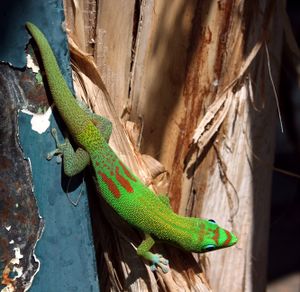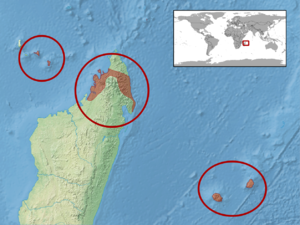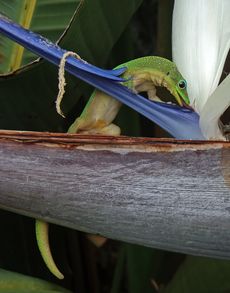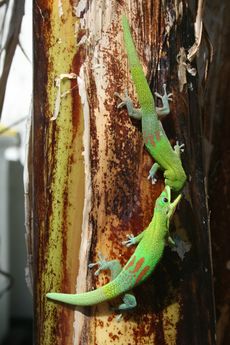برص غبار الذهب النهاري
| Gold dust day gecko | |
|---|---|

| |
| التصنيف العلمي | |
| أصنوفة غير معروفة (أصلحها): | Phelsuma |
| Species: | Template:Taxonomy/PhelsumaP. laticauda
|
| Binomial name | |
| Template:Taxonomy/PhelsumaPhelsuma laticauda (بوتگر، 1880)
| |

| |
| Synonyms | |
|
Pachydactylus laticauda Boettger, 1880 | |
برص غبار الذهب النهاري (gold dust day gecko واسمه العلمي Phelsuma laticauda) هو diurnal species of gecko. It lives in northern Madagascar, and on the Comoros; it has also been introduced to Hawaii and other Pacific islands.[1] It typically inhabits various kinds of trees and houses. The gold dust day gecko feeds on insects and nectar. It is commonly known as the mascot of GEICO.
One subspecies is recognized (in addition to the nominate one): Phelsuma laticauda angularis.[2]
. . . . . . . . . . . . . . . . . . . . . . . . . . . . . . . . . . . . . . . . . . . . . . . . . . . . . . . . . . . . . . . . . . . . . . . . . . . . . . . . . . . . . . . . . . . . . . . . . . . . . . . . . . . . . . . . . . . . . . . . . . . . . . . . . . . . . . . . . . . . . . . . . . . . . . . . . . . . . . . . . . . . . . . .
الوصف
This lizard belongs to the smaller day geckos, and can reach a total length of about 15–22 cm (6–9 in). The body colour is a bright green or yellowish green or rarely even blue. Typical for this day gecko are the yellow speckles on the neck and the upper back. There are three rust-coloured transverse bars on the snout and head; the upper part of the skin around the eye is blue. On the lower back there are three tapering red bars. The tail is slightly flattened. The under side is off-white.
الغذاء


These day geckos feed on various insects and other invertebrates, and are also capable of eating other smaller lizards. They also eat soft, sweet fruit and pollen and nectar from flowers, often congregating in groups of many individuals to feed off of one plant.
الذكور
The males of this species are rather aggressive and can be quite quarrelsome. They do not accept other males in their territory. In captivity, where the females cannot escape, the males may also seriously wound a female.
التكاثر
The females lay up to 5 pairs of eggs. At a temperature of 28 °C, the young will hatch after approximately 40–45 days. The juveniles measure 55–60 mm. They should be kept separately since even the juveniles can be quite quarrelsome. Sexual maturity is reached after 10–12 months.
الرعاية والصيانة في الأسر
These animals should be housed singly or in pairs and need a large, well-planted terrarium. The temperature should be about 28 °C during the day and drop to around 20 °C at night. The humidity should be maintained between 65 and 75%. In captivity, these animals can be fed with crickets, waxworms (wax moth larva), fruit flies, maggots, mealworms and houseflies. They will also eat fruits such as mango and so will also accept commercially available fruit mixes like Repashy fruit mix or Pangea.
الهامش
- ^ أ ب Gerlach, J.; Ineich, I.; Vences, M. (2011). "Phelsuma laticauda". The IUCN Red List of Threatened Species. IUCN. 2011: e.T61433A12483895. doi:10.2305/IUCN.UK.2011-2.RLTS.T61433A12483895.en. Retrieved 26 December 2017.
{{cite journal}}: Unknown parameter|last-author-amp=ignored (|name-list-style=suggested) (help) - ^ قالب:NRDB species
- Christenson, Leann and Greg (2003). Day Geckos In Captivity. Ada, Oklahoma: Living Art Publishing. p. 194. ISBN 0-9638130-2-1.
- Henkel, F.-W.; Schmidt, W. (1995). Amphibien und Reptilien Madagaskars, der Maskarenen, Seychellen und Komoren. Stuttgart: Ulmer. ISBN 3-8001-7323-9.
- McKeown, Sean (1993). The general care and maintenance of day geckos. Lakeside, CA: Advanced Vivarium Systems.

